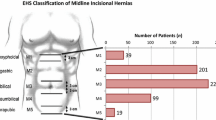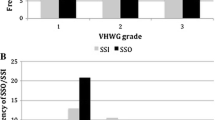Abstract
Background
The purpose of this study was to compare the incidence of postoperative surgical site infections (SSIs), operative times (OTs), and length of hospital stay (LOS) after open and laparoscopic ventral/incisional hernia repair (VIHR) using multicenter, prospectively collected data.
Methods
The incidence of postoperative SSIs, OTs, and LOS was determined for cases of VIHR in the American College of Surgeons’ National Surgical Quality Improvement Program database in 2009 and 2010. Open and laparoscopic techniques were compared using a propensity score model to adjust for differences in patient demographics, characteristics, comorbidities, and laboratory values.
Results
A total of 26,766 cases met the inclusion criteria; 21,463 cases were open procedures (reducible, n = 15,520 [72 %]; incarcerated/strangulated, n = 5,943 [28 %]), and 5,303 cases were laparoscopic procedures (reducible, n = 3,883 [73 %]; incarcerated/strangulated, n = 1,420 [27 %]). Propensity score adjusted odds ratios (ORs) were significantly different between open and laparoscopic VIHR for reducible and incarcerated/strangulated hernias with regard to superficial SSI (OR 5.5, p < 0.01 and OR 3.1, p < 0.01, respectively), deep SSI (OR 6.9, p < 0.01, and OR 8.0, p < 0.01, respectively) and wound disruption (OR 4.6, p < 0.01 and OR 9.3, p = 0.03, respectively). The risk for organ/space SSI was significantly greater for open operations among reducible hernias (OR 1.9, p = 0.02), but there was no significant difference between the open and laparoscopic repair groups for incarcerated/strangulated hernias (OR 0.8, p = 0.41). The OT was significantly longer for laparoscopic procedures, both for reducible (98.5 vs. 84.9 min, p < 0.01) and incarcerated/strangulated hernias (96.4 vs. 81.2 min, p < 0.01). LOS (mean, 95 % confidence interval) was significantly longer for open repairs for both reducible (open = 2.79, 2.59–3.00; laparoscopic = 2.39, 2.20–2.60; p < 0.01) and incarcerated/strangulated (open = 2.64, 2.55–2.73; laparoscopic = 2.17, 2.02–2.33; p < 0.01) hernias.
Conclusions
Laparoscopic VIHR for reducible and incarcerated/strangulated hernias is associated with shorter LOS and decreased risk for superficial SSI, deep SSI, and wound disruption, but longer OTs when compared to open repair.
Similar content being viewed by others
References
DeFrances CJ, Cullen KA, Kozak LJ (2007) National Hospital Discharge Survey: 2005 annual summary with detailed diagnosis and procedure data. Vital Health Stat 13:1–209
Hoer JJ, Junge K, Schachtrupp A, Klinge U, Schumpelick V (2002) Influence of laparotomy closure technique on collagen synthesis in the incisional region. Hernia 6:93–98
Lomanto D, Iyer SG, Shabbir A, Cheah WK (2006) Laparoscopic versus open ventral hernia mesh repair: a prospective study. Surg Endosc 20:1030–1035
Mudge M, Hughes LE (1985) Incisional hernia: a 10 year prospective study of incidence and attitudes. Br J Surg 72:70–71
Cassar K, Munro A (2002) Surgical treatment of incisional hernia. Br J Surg 89:534–545
Iqbal CW, Pham TH, Joseph A, Mai J, Thompson GB, Sarr MG (2007) Long-term outcome of 254 complex incisional hernia repairs using the modified Rives-Stoppa technique. World J Surg 31:2398–2404
Luijendijk RW, Hop WC, van den Tol MP, de Lange DC, Braaksma MM, JN IJ, Boelhouwer RU, de Vries BC, Salu MK, Wereldsma JC, Bruijninckx CM, Jeekel J (2000) A comparison of suture repair with mesh repair for incisional hernia. N Engl J Med 343:392–398
Read RC, Yoder G (1989) Recent trends in the management of incisional herniation. Arch Surg 124:485–488
van der Linden FT, van Vroonhoven TJ (1988) Long-term results after surgical correction of incisional hernia. Neth J Surg 40:127–129
Liakakos T, Karanikas I, Panagiotidis H, Dendrinos S (1994) Use of Marlex mesh in the repair of recurrent incisional hernia. Br J Surg 81:248–249
Toniato A, Pagetta C, Bernante P, Piotto A, Pelizzo MR (2002) Incisional hernia treatment with progressive pneumoperitoneum and retromuscular prosthetic hernioplasty. Langenbecks Arch Surg 387:246–248
LeBlanc KA, Booth WV (1993) Laparoscopic repair of incisional abdominal hernias using expanded polytetrafluoroethylene: preliminary findings. Surg Laparosc Endosc 3:39–41
Sauerland S, Walgenbach M, Habermalz B, Seiler CM, Miserez M (2011) Laparoscopic versus open surgical techniques for ventral or incisional hernia repair. Cochrane Database Syst Rev (3) CD007781. doi:10.1002/14651858.CD007781.pub2
Khuri SF, Daley J, Henderson W, Hur K, Demakis J, Aust JB, Chong V, Fabri PJ, Gibbs JO, Grover F, Hammermeister K, Irvin G III, McDonald G, Passaro E Jr, Phillips L, Scamman F, Spencer J, Stremple JF (1998) The Department of Veterans Affairs’ NSQIP: the first national, validated, outcome-based, risk-adjusted, and peer-controlled program for the measurement and enhancement of the quality of surgical care. National VA Surgical Quality Improvement Program. Ann Surg 228:491–507
Hilbe JM (2007) Negative binomial regression. Cambridge University Press, Cambridge
LeBlanc KA (2000) Current considerations in laparoscopic incisional and ventral herniorrhaphy. JSLS 4:131–139
Chowbey PK, Sharma A, Khullar R, Mann V, Baijal M, Vashistha A (2000) Laparoscopic ventral hernia repair. J Laparoendosc Adv Surg Tech A 10:79–84
Carbajo MA, Martin del Olmo JC, Blanco JI, de la Cuesta C, Toledano M, Martin F, Vaquero C, Inglada L (1999) Laparoscopic treatment vs open surgery in the solution of major incisional and abdominal wall hernias with mesh. Surg Endosc 13:250–252
Heniford BT, Park A, Ramshaw BJ, Voeller G (2000) Laparoscopic ventral and incisional hernia repair in 407 patients. J Am Coll Surg 190:645–650
Park A, Birch DW, Lovrics P (1998) Laparoscopic and open incisional hernia repair: a comparison study. Surgery 124:816–821
Misra MC, Bansal VK, Kulkarni MP, Pawar DK (2006) Comparison of laparoscopic and open repair of incisional and primary ventral hernia: results of a prospective randomized study. Surg Endosc 20:1839–1845
Barbaros U, Asoglu O, Seven R, Erbil Y, Dinccag A, Deveci U, Ozarmagan S, Mercan S (2007) The comparison of laparoscopic and open ventral hernia repairs: a prospective randomized study. Hernia 11:51–56
Navarra G, Musolino C, De Marco ML, Bartolotta M, Barbera A, Centorrino T (2007) Retromuscular sutured incisional hernia repair: a randomized controlled trial to compare open and laparoscopic approach. Surg Laparosc Endosc Percutan Tech 17:86–90
Olmi S, Scaini A, Cesana GC, Erba L, Croce E (2007) Laparoscopic versus open incisional hernia repair: an open randomized controlled study. Surg Endosc 21:555–559
Asencio F, Aguilo J, Peiro S, Carbo J, Ferri R, Caro F, Ahmad M (2009) Open randomized clinical trial of laparoscopic versus open incisional hernia repair. Surg Endosc 23:1441–1448
Colavita PD, Tsirline VB, Walters AL, Lincourt AE, Belyansky I, Heniford BT (2013) Laparoscopic versus open hernia repair: outcomes and sociodemographic utilization results from the nationwide inpatient sample. Surg Endosc 27(1):109–117
Alvarez Perez JA, Baldonedo RF, Bear IG, Solis JA, Alvarez P, Jorge JI (2003) Emergency hernia repairs in elderly patients. Int Surg 88:231–237
Nieuwenhuizen J, van Ramshorst GH, ten Brinke JG, de Wit T, van der Harst E, Hop WC, Jeekel J, Lange JF (2011) The use of mesh in acute hernia: frequency and outcome in 99 cases. Hernia 15:297–300
Mason RJ, Moazzez A, Sohn HJ, Berne TV, Katkhouda N (2011) Laparoscopic versus open anterior abdominal wall hernia repair: 30-day morbidity and mortality using the ACS-NSQIP database. Ann Surg 254:641–652
Sajid MS, Bokhari SA, Mallick AS, Cheek E, Baig MK (2009) Laparoscopic versus open repair of incisional/ventral hernia: a meta-analysis. Am J Surg 197:64–72
Berger D, Bientzle M, Muller A (2002) Postoperative complications after laparoscopic incisional hernia repair. Incidence and treatment. Surg Endosc 16:1720–1723
LeBlanc KA, Elieson MJ, Corder JM 3rd (2007) Enterotomy and mortality rates of laparoscopic incisional and ventral hernia repair: a review of the literature. JSLS 11:408–414
Forbes SS, Eskicioglu C, McLeod RS, Okrainec A (2009) Meta-analysis of randomized controlled trials comparing open and laparoscopic ventral and incisional hernia repair with mesh. Br J Surg 96:851–858
Hwang CS, Wichterman KA, Alfrey EJ (2009) Laparoscopic ventral hernia repair is safer than open repair: analysis of the NSQIP data. J Surg Res 156:213–216
Pring CM, Tran V, O’Rourke N, Martin IJ (2008) Laparoscopic versus open ventral hernia repair: a randomized controlled trial. ANZ J Surg 78:903–906
de Lissovoy G, Fraeman K, Hutchins V, Murphy D, Song D, Vaughn BB (2009) Surgical site infection: incidence and impact on hospital utilization and treatment costs. Am J Infect Control 37:387–397
Wick EC, Hirose K, Shore AD, Clark JM, Gearhart SL, Efron J, Makary MA (2011) Surgical site infections and cost in obese patients undergoing colorectal surgery. Arch Surg 146:1068–1072
Hutter MM, Randall S, Khuri SF, Henderson WG, Abbott WM, Warshaw AL (2006) Laparoscopic versus open gastric bypass for morbid obesity: a multicenter, prospective, risk-adjusted analysis from the National Surgical Quality Improvement Program. Ann Surg 243:657–662
Leichtle SW, Mouawad NJ, Welch K, Lampman R, Whitehouse WM Jr, Heidenreich M (2012) Outcomes of carotid endarterectomy under general and regional anesthesia from the American College of Surgeons’ National Surgical Quality Improvement Program. J Vasc Surg 56(81–88):e83
D’Agostino RB Jr (2007) Propensity scores in cardiovascular research. Circulation 115:2340–2343
Kennedy GD, Rajamanickam V, O’Connor ES, Loconte NK, Foley EF, Leverson G, Heise CP (2011) Optimizing surgical care of colon cancer in the older adult population. Ann Surg 253:508–514
Disclosures
Drs. Christodoulos Kaoutzanis, Stefan W. Leichtle, Nicolas J. Mouawad, Richard M. Lampman, and Robert K. Cleary, and Ms. Kathleen B. Welch have no conflicts of interest or financial ties to disclose.
Author information
Authors and Affiliations
Corresponding author
Rights and permissions
About this article
Cite this article
Kaoutzanis, C., Leichtle, S.W., Mouawad, N.J. et al. Postoperative surgical site infections after ventral/incisional hernia repair: a comparison of open and laparoscopic outcomes. Surg Endosc 27, 2221–2230 (2013). https://doi.org/10.1007/s00464-012-2743-0
Received:
Accepted:
Published:
Issue Date:
DOI: https://doi.org/10.1007/s00464-012-2743-0




